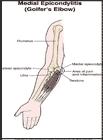
Medial Epicondylitis (Golfer's Elbow)
What is medial epicondylitis (golfer's elbow)?
Medial epicondylitis (golfer's elbow) is a painful inflammation of the bony bump on the inner side of the elbow.
The elbow joint is made up of the bone in the upper arm (humerus) and one of the bones in the lower arm (ulna). The bony bumps at the bottom of the humerus are called the epicondyles. The bump on the side closest to the body is called the medial epicondyle, and the bump on the outer side of the elbow is called the lateral epicondyle.
The tendons of the muscles that work to bend your wrist attach at the medial epicondyle. Medial epicondylitis is also referred to as wrist flexor tendonitis.
How does it occur?
Golfer's elbow occurs from overuse of the muscles that enable you to bend your fingers and wrist. When these muscles are overused, the tendons are repeatedly tugged at their point of attachment (the medial epicondyle). As a result, the tendons become inflamed (tendonitis), and repeated, tiny tears in the tendon tissue cause pain. This commonly happens in sports such as golf, in throwing sports, and in racquet sports. It also may happen in work activities like carpentry or typing.
What are the symptoms?
Golfer's elbow causes pain in the elbow at the side closest to the body. You may also have pain along the entire inner side of the forearm when the wrist is bent. You may have pain when you make a fist.
How is it diagnosed?
Your health care provider will examine your elbow and find tenderness at the medial epicondyle.
How is it treated?
You should apply ice packs to your elbow for 20 to 30 minutes every 3 to 4 hours for 2 or 3 days or until the pain goes away.
If your elbow is swollen, you should elevate it by placing a pillow underneath it when you are lying down and by elevating it on the back of a chair or couch while sitting. You may be given an elastic bandage to wrap around your elbow to keep it from swelling.
While you are recovering from your injury, you will need to change your sport or activity to one that does not make your condition worse. For example, instead of playing golf you should walk, or write things out by hand instead of typing.
Your health care provider may prescribe a tennis elbow strap for you to wear just below the tender spot on your elbow. This will allow the forearm muscles to pull against the strap instead of against the painful epicondyle. Your provider may prescribe an anti-inflammatory medication. He or she may give you an shot of a corticosteroid medication around the medial epicondyle to reduce the inflammation. You will be given elbow exercises. In severe cases of medial epicondylitis you may need surgery.
When can I return to my sport or activity?
The goal of rehabilitation is to return you to your sport or activity as soon as is safely possible. If you return too soon you may worsen your injury, which could lead to permanent damage. Everyone recovers from injury at a different rate. Return to your sport or activity will be determined by how soon your elbow recovers, not by how many days or weeks it has been since your injury occurred. In general, the longer you have symptoms before you start treatment, the longer it will take to get better.
You may return when your are able to forcefully grip your tennis racquet, bat, or golf club, or do activities such as working at a keyboard without pain in your elbow. In sports such as gymnastics, it is important that you are able to bear weight on your elbow painlessly. It is important that there is no swelling around your injured elbow and that it has regained its normal strength compared to the uninjured elbow. You must have full range of motion of your elbow.
How can it be prevented?
Since medial epicondylitis occurs because of overuse to the muscles that bend your wrist, it is important that you do not allow this overactivity to occur. At the earliest signs of pain on the inner side of your elbow, you should slow your activity down and seek treatment. Wearing a tennis elbow strap and doing elbow stretching exercises will help prevent medial epicondylitis.

